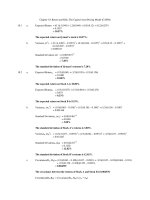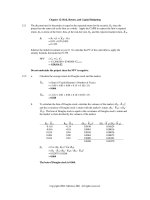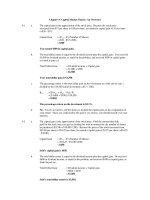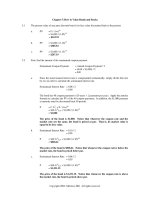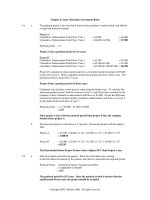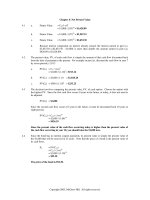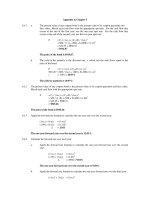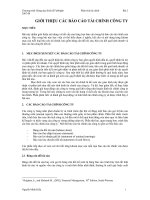Tài liệu Tài chính doanh nghiệp ( Bài tập)_ Chapter 10 doc
Bạn đang xem bản rút gọn của tài liệu. Xem và tải ngay bản đầy đủ của tài liệu tại đây (322.98 KB, 35 trang )
Chapter 10: Return and Risk: The Capital Asset Pricing Model (CAPM)
10.1 a. Expected Return = (0.1)(-0.045) + (.2)(0.044) + (0.5)(0.12) + (0.2)(0.207)
= 0.1057
= 10.57%
The expected return on Q-mart’s stock is 10.57%.
b. Variance (σ
2
) = (0.1)(-0.045 – 0.1057)
2
+ (0.2)(0.044 – 0.1057)
2
+ (0.5)(0.12 – 0.1057)
2
+
(0.2)(0.207 – 0.1057)
2
= 0.005187
Standard Deviation (σ) = (0.005187)
1/2
= 0.0720
= 7.20%
The standard deviation of Q-mart’s returns is 7.20%.
10.2 a. Expected Return
A
= (1/3)(0.063) + (1/3)(0.105) + (1/3)(0.156)
= 0.1080
= 10.80%
The expected return on Stock A is 10.80%.
Expected Return
B
= (1/3)(-0.037) + (1/3)(0.064) + (1/3)(0.253)
B
= 0.933
= 9.33%
The expected return on Stock B is 9.33%.
b. Variance
A
(σ
A
2
) = (1/3)(0.063 – 0.108)
2
+ (1/3)(0.105 – 0.108)
2
+ (1/3)(0.156 – 0.108)
2
= 0.001446
Standard Deviation
A
(σ
A
) = (0.001446)
1/2
= 0.0380
= 3.80%
The standard deviation of Stock A’s returns is 3.80%.
Variance
B
(σ
B
B
2
) = (1/3)(-0.037 – 0.0933) + (1/3)(0.064 – 0.0933) + (1/3)(0.253 – 0.0933)
2 2 2
= 0.014447
Standard Deviation
B
(σ
B
B
B
) = (0.014447)
1/2
= 0.1202
= 12.02%
The standard deviation of Stock B’s returns is 12.02%.
c. Covariance(R
A
, R
B
) = (1/3)(0.063 – 0.108)(-0.037 – 0.0933) + (1/3)(0.105 – 0.108)(0.064 – 0.933)
B
+ (1/3)(0.156 – 0.108)(0.253 – 0.0933)
= 0.004539
The covariance between the returns of Stock A and Stock B is 0.004539.
Correlation(R
A
,R
B
) = Covariance(R
B
A
, R
B
B
) / (σ
A
* σ
B
)
B
= 0.004539 / (0.0380 * 0.1202)
= 0.9937
The correlation between the returns on Stock A and Stock B is 0.9937.
10.3 a. Expected Return
HB
= (0.25)(-0.02) + (0.60)(0.092) + (0.15)(0.154)
= 0.0733
= 7.33%
The expected return on Highbull’s stock is 7.33%.
Expected Return
SB
= (0.25)(0.05) + (0.60)(0.062) + (0.15)(0.074)
= 0.0608
= 6.08%
The expected return on Slowbear’s stock is 6.08%.
b. Variance
A
(σ
HB
2
) = (0.25)(-0.02 – 0.0733)
2
+ (0.60)(0.092 – 0.0733)
2
+ (0.15)(0.154 – 0.0733)
2
= 0.003363
Standard Deviation
A
(σ
HB
) = (0.003363)
1/2
= 0.0580
= 5.80%
The standard deviation of Highbear’s stock returns is 5.80%.
Variance
B
(σ
B
SB
2
) = (0.25)(0.05 – 0.0608) + (0.60)(0.062 – 0.0608) + (0.15)(0.074 – 0.0608)
2 2 2
= 0.000056
Standard Deviation
B
(σ
B
B
B
) = (0.000056)
1/2
= 0.0075
= 0.75%
The standard deviation of Slowbear’s stock returns is 0.75%.
c. Covariance(R
HB
, R
SB
) = (0.25)(-0.02 – 0.0733)(0.05 – 0.0608) + (0.60)(0.092 – 0.0733)(0.062 –
(0.0608) + (0.15)(0.154 – 0.0733)(0.074 – 0.0608)
= 0.000425
The covariance between the returns on Highbull’s stock and Slowbear’s stock is 0.000425.
Correlation(R
A
,R
B
) = Covariance(R
B
A
, R
B
B
) / (σ
A
* σ
B
)
B
= 0.000425 / (0.0580 * 0.0075)
= 0.9770
The correlation between the returns on Highbull’s stock and Slowbear’s stock is 0.9770.
10.4 Value of Atlas stock in the portfolio = (120 shares)($50 per share)
= $6,000
Value of Babcock stock in the portfolio = (150 shares)($20 per share)
= $3,000
Total Value in the portfolio = $6,000 + $3000
= $9,000
Weight of Atlas stock = $6,000 / $9,000
= 2/3
The weight of Atlas stock in the portfolio is 2/3.
Weight of Babcock stock = $3,000 / $9,000
= 1/3
The weight of Babcock stock in the portfolio is 1/3.
10.5 a. The expected return on the portfolio equals:
E(R
P
) = (W
F
)[E(R
F
)] + (W
G
)[E(R
G
)]
where E(R
P
) = the expected return on the portfolio
E(R
F
) = the expected return on Security F
E(R
G
) = the expected return on Security G
W
F
= the weight of Security F in the portfolio
W
G
= the weight of Security G in the portfolio
E(R
P
) = (W
F
)[E(R
F
)] + (W
G
)[E(R
G
)]
= (0.30)(0.12) + (0.70)(0.18)
= 0.1620
= 16.20%
The expected return on a portfolio composed of 30% of Security F and 70% of Security G is
16.20%.
b. The variance of the portfolio equals:
σ
2
P
= (W
F
)
2
(σ
F
)
2
+ (W
G
)
2
(σ
G
)
2
+ (2)(W
F
)(W
G
)(σ
F
)(σ
G
)[Correlation(R
F
, R
G
)]
where σ
2
P
= the variance of the portfolio
W
F
= the weight of Security F in the portfolio
W
G
= the weight of Security G in portfolio
σ
F
= the standard deviation of Security F
σ
G
= the standard deviation of Security G
R
F
= the return on Security F
R
G
= the return on Security G
σ
2
P
= (W
F
)
2
(σ
F
)
2
+ (W
G
)
2
(σ
G
)
2
+ (2)(W
F
)(W
G
)(σ
F
)(σ
G
)[Correlation(R
F
, R
G
)]
= (0.30)
2
(0.09)
2
+ (0.70)
2
(0.25)
2
+ (2)(0.30)(0.70)(0.09)(0.25)(0.2)
= 0.033244
The standard deviation of the portfolio equals:
σ
P
= (σ
2
P
)
1/2
where σ
P
= the standard deviation of the portfolio
σ
2
P
= the variance of the portfolio
σ
P
= (σ
2
P
)
1/2
= (0.033244)
1/2
= 0.1823
=18.23%
If the correlation between the returns of Security F and Security G is 0.2, the standard
deviation of the portfolio is 18.23%.
10.6 a. The expected return on the portfolio equals:
E(R
P
) = (W
A
)[E(R
A
)] + (W
B
)[E(R
B
B
B
)]
where E(R
P
) = the expected return on the portfolio
E(R
A
) = the expected return on Stock A
E(R
B
) = the expected return on Stock B
B
W
A
= the weight of Stock A in the portfolio
W
B
= the weight of Stock B in the portfolio
E(R
P
) = (W
A
)[E(R
A
)] + (W
B
)[E(R
B
B
B
)]
= (0.40)(0.15) + (0.60)(0.25)
= 0.21
= 21%
The expected return on a portfolio composed of 40% stock A and 60% stock B is 21%.
The variance of the portfolio equals:
σ
2
P
= (W
A
)
2
(σ
A
)
2
+ (W
B
) (σ
B
2
B
B
)
2
+ (2)(W
A
)(W
B
)(σ
B
A
)(σ
B
B
)[Correlation(R
A
, R
B
)]
B
where σ
2
P
= the variance of the portfolio
W
A
= the weight of Stock A in the portfolio
W
B
= the weight of Stock B in the portfolio
σ
A
= the standard deviation of Stock A
σ
B
= the standard deviation of Stock B
R
A
= the return on Stock A
R
B
= the return on Stock B
B
σ
2
P
= (W
A
)
2
(σ
A
)
2
+ (W
B
) (σ
B
2
B
B
)
2
+ (2)(W
A
)(W
B
)(σ
B
A
)(σ
B
B
)[Correlation(R
A
, R
B
)]
B
= (0.40)
2
(0.10)
2
+ (0.60)
2
(0.20)
2
+ (2)(0.40)(0.60)(0.10)(0.20)(0.5)
= 0.0208
The standard deviation of the portfolio equals:
σ
P
= (σ
2
P
)
1/2
where σ
P
= the standard deviation of the portfolio
σ
2
P
= the variance of the portfolio
σ
P
= (0.0208)
1/2
= 0.1442
=14.42%
If the correlation between the returns on Stock A and Stock B is 0.5, the standard deviation
of the portfolio is 14.42%.
b. σ
2
P
= (W
A
)
2
(σ
A
)
2
+ (W
B
) (σ
B
2
B
B
)
2
+ (2)(W
A
)(W
B
)(σ
B
A
)(σ
B
B
)[Correlation(R
A
, R
B
)]
B
= (0.40)
2
(0.10)
2
+ (0.60)
2
(0.20)
2
+ (2)(0.40)(0.60)(0.10)(0.20)(-0.5)
= 0.0112
σ
P
= (0.0112)
1/2
= 0.1058
=10.58%
If the correlation between the returns on Stock A and Stock B is -0.5, the standard deviation
of the portfolio is 10.58%.
c. As Stock A and Stock B become more negatively correlated, the standard deviation of the
portfolio decreases.
10.7 a. Value of Macrosoft stock in the portfolio = (100 shares)($80 per share)
= $8,000
Value of Intelligence stock in the portfolio = (300 shares)($40 per share)
= $12,000
Total Value in the portfolio = $8,000 + $12,000
= $20,000
Weight of Macrosoft stock = $8,000 / $20,000
= 0.40
Weight of Intelligence stock = $12,000 / $20,000
= 0.60
The expected return on the portfolio equals:
E(R
P
) = (W
MAC
)[E(R
MAC
)] + (W
I
)[E(R
I
)]
where E(R
P
) = the expected return on the portfolio
E(R
MAC
) = the expected return on Macrosoft stock
E(R
I
) = the expected return on Intelligence Stock
W
MAC
= the weight of Macrosoft stock in the portfolio
W
I
= the weight of Intelligence stock in the portfolio
E(R
P
) = (W
MAC
)[E(R
MAC
)] + (W
I
)[E(R
M
)]
= (0.40)(0.15) + (0.60)(0.20)
= 0.18
= 18%
The expected return on her portfolio is 18%.
The variance of the portfolio equals:
σ
2
P
= (W
MAC
)
2
(σ
MAC
)
2
+ (W
I
)
2
(σ
I
)
2
+ (2)(W
MAC
)(W
I
)(σ
MAC
)(σ
I
)[Correlation(R
MAC
, R
I
)]
where σ
2
P
= the variance of the portfolio
W
MAC
= the weight of Macrosoft stock in the portfolio
W
I
= the weight of Intelligence stock in the portfolio
σ
MAC
= the standard deviation of Macrosoft stock
σ
I
= the standard deviation of Intelligence stock
R
MAC
= the return on Macrosoft stock
R
I
= the return on Intelligence stock
σ
2
P
= (W
MAC
)
2
(σ
MAC
)
2
+ (W
I
)
2
(σ
I
)
2
+ (2)(W
MAC
)(W
I
)(σ
MAC
)(σ
I
)[Correlation(R
MAC
, R
I
)]
= (0.40)
2
(0.08)
2
+ (0.60)
2
(0.20)
2
+ (2)(0.40)(0.60)(0.08)(0.20)(0.38)
= 0.018342
The standard deviation of the portfolio equals:
σ
P
= (σ
2
P
)
1/2
where σ
P
= the standard deviation of the portfolio
σ
2
P
= the variance of the portfolio
σ
P
= (0.018342)
1/2
= 0.1354
=13.54%
The standard deviation of her portfolio is 13.54%.
b. Janet started with 300 shares of Intelligence stock. After selling 200 shares, she has 100 shares
left.
Value of Macrosoft stock in the portfolio = (100 shares)($80 per share)
= $8,000
Value of Intelligence stock in the portfolio = (100 shares)($40 per share)
= $4,000
Total Value in the portfolio = $8,000 + $4,000
= $12,000
Weight of Macrosoft stock = $8,000 / $12,000
= 2/3
Weight of Intelligence stock = $4,000 / $12,000
= 1/3
E(R
P
) = (W
MAC
)[E(R
MAC
)] + (W
I
)[E(R
I
)]
= (2/3)(0.15) + (1/3)(0.20)
= 0.1667
= 16.67%
The expected return on her portfolio is 16.67%.
σ
2
P
= (W
MAC
)
2
(σ
MAC
)
2
+ (W
I
)
2
(σ
I
)
2
+ (2)(W
MAC
)(W
I
)(σ
MAC
)(σ
I
)[Correlation(R
MAC
, R
I
)]
= (2/3)
2
(0.08)
2
+ (1/3)
2
(0.20)
2
+ (2)(2/3)(1/3)(0.08)(0.20)(0.38)
= 0.009991
σ
P
= (0.009991)
1/2
= 0.1000
=10.00%
The standard deviation of her portfolio is 10.00%.
10.8 a. Expected Return
A
= (0.20)(0.07) + (0.50)(0.07) + (0.30)(0.07)
= 0.07
= 7%
The expected return on Stock A is 7%.
Variance
A
(σ
A
2
) = (0.20)(0.07 – 0.07)
2
+ (0.50)(0.07 – 0.07)
2
+ (0.30)(0.07 – 0.07)
2
= 0
The variance of the returns on Stock A is 0.
Standard Deviation
A
(σ
A
) = (0)
1/2
= 0.00
= 0%
The standard deviation of the returns on Stock A is 0%.
Expected Return
B
= (0.20)(-0.05) + (0.50)(0.10) + (0.30)(0.25)
B
= 0.1150
= 11.50%
The expected return on Stock B is 11.50%.
Variance
B
(σ
B
B
2
) = (0.20)(-0.05 – 0.1150) + (0.50)(0.10 – 0.1150) + (0.30)(0.25 – 0.1150)
2 2 2
= 0.011025
The variance of the returns on Stock B is 0.011025.
Standard Deviation
B
(σ
B
B
B
) = (0.011025)
1/2
= 0.1050
=10.50%
The standard deviation of the returns on Stock B is 10.50%.
b. Covariance(R
A
, R
B
) = (0.20)(0.07 – 0.07)(-0.05 – 0.1150) + (0.50)(0.07 – 0.07)(0.10 – 0.1150)
B
(0.30)(0.07 – 0.07)(0.25 – 0.1150)
= 0
The covariance between the returns on Stock A and Stock B is 0.
Correlation(R
A
,R
B
) = Covariance(R
B
A
, R
B
B
) / (σ
A
* σ
B
)
B
= 0 / (0 * 0.1050)
= 0
The correlation between the returns on Stock A and Stock B is 0.
c. The expected return on the portfolio equals:
E(R
P
) = (W
A
)[E(R
A
)] + (W
B
)[E(R
B
B
B
)]
where E(R
P
) = the expected return on the portfolio
E(R
A
) = the expected return on Stock A
E(R
B
) = the expected return on Stock B
B
W
A
= the weight of Stock A in the portfolio
W
B
= the weight of Stock B in the portfolio
E(R
P
) = (W
A
)[E(R
A
)] + (W
B
)[E(R
B
B
B
)]
= (1/2)(0.07) + (1/2)(0.115)
= 0.0925
= 9.25%
The expected return of an equally weighted portfolio is 9.25%.
σ
2
P
= (W
A
)
2
(σ
A
)
2
+ (W
B
) (σ
B
2
B
B
)
2
+ (2)(W
A
)(W
B
)(σ
B
A
)(σ
B
B
)[Correlation(R
A
, R
B
)]
B
where σ
2
P
= the variance of the portfolio
W
A
= the weight of Stock A in the portfolio
W
B
= the weight of Stock B in the portfolio
σ
A
= the standard deviation of Stock A
σ
B
= the standard deviation of Stock B
R
A
= the return on Stock A
R
B
= the return Stock B
σ
2
P
= (W
A
)
2
(σ
A
)
2
+ (W
B
) (σ
B
2
B
B
)
2
+ (2)(W
A
)(W
B
)(σ
B
A
)(σ
B
B
)[Correlation(R
A
, R
B
)]
B
= (1/2)
2
(0)
2
+ (1/2)
2
(0.105)
2
+ (2)(1/2)(1/2)(0)(0.105)(0)
= 0.002756
The standard deviation of the portfolio equals:
σ
P
= (σ
2
P
)
1/2
where σ
P
= the standard deviation of the portfolio
σ
2
P
= the variance of the portfolio
σ
P
= (0.002756)
1/2
= 0.0525
=5.25%
The standard deviation of the returns on an equally weighted portfolio is 5.25%.
10.9 a. The expected return on the portfolio equals:
E(R
P
) = (W
A
)[E(R
A
)] + (W
B
)[E(R
B
B
B
)]
where E(R
P
) = the expected return on the portfolio
E(R
A
) = the expected return on Stock A
E(R
B
) = the expected return on Stock B
B
W
A
= the weight of Stock A in the portfolio
W
B
= the weight of Stock B in the portfolio
E(R
P
) = (W
A
)[E(R
A
)] + (W
B
)[E(R
B
B
B
)]
= (0.30)(0.10) + (0.70)(0.20)
= 0.17
= 17%
The expected return on the portfolio is 17%.
The variance of a portfolio equals:
σ
2
P
= (W
A
)
2
(σ
A
)
2
+ (W
B
) (σ
B
2
B
B
)
2
+ (2)(W
A
)(W
B
)(σ
B
A
)(σ
B
B
)[Correlation(R
A
, R
B
)]
B
where σ
2
P
= the variance of the portfolio
W
A
= the weight of Stock A in the portfolio
W
B
= the weight of Stock B in the portfolio
σ
A
= the standard deviation of Stock A
σ
B
= the standard deviation of Stock B
R
A
= the return on Stock A
R
B
= the return on Stock B
σ
2
P
= (W
A
)
2
(σ
A
)
2
+ (W
B
) (σ
B
2
B
B
)
2
+ (2)(W
A
)(W
B
)(σ
B
A
)(σ
B
B
)[Correlation(R
A
, R
B
)]
B
= (0.30)
2
(0.05)
2
+ (0.70)
2
(0.15)
2
+ (2)(0.30)(0.70)(0.05)(0.15)(0)
= 0.01125
The standard deviation of the portfolio equals:
σ
P
= (σ
2
P
)
1/2
where σ
P
= the standard deviation of the portfolio
σ
2
P
= the variance of the portfolio
σ
P
= (0.01125)
1/2
= 0.1061
= 10.61%
The standard deviation of the portfolio is 10.61%.
b. E(R
P
) = (W
A
)[E(R
A
)] + (W
B
)[E(R
B
B
B
)]
= (0.90)(0.10) + (0.10)(0.20)
= 0.11
= 11%
The expected return on the portfolio is 11%.
σ
2
P
= (W
A
)
2
(σ
A
)
2
+ (W
B
) (σ
B
2
B
B
)
2
+ (2)(W
A
)(W
B
)(σ
B
A
)(σ
B
B
)[Correlation(R
A
, R
B
)]
B
= (0.90)
2
(0.05)
2
+ (0.10)
2
(0.15)
2
+ (2)(0.90)(0.10)(0.05)(0.15)(0)
= 0.00225
σ
P
= (0.00225)
1/2
= 0.0474
= 4.74%
The standard deviation of the portfolio is 4.74%.
c. No, you would not hold 100% of Stock A because the portfolio in part b has a higher expected
return and lower standard deviation than Stock A.
You may or may not hold 100% of Stock B, depending on your risk preference. If you have a low
level of risk-aversion, you may prefer to hold 100% Stock B because of its higher expected return.
If you have a high level of risk-aversion, however, you may prefer to hold a portfolio containing
both Stock A and Stock B since the portfolio will have a lower standard deviation, and hence, less
risk, than holding Stock B alone.
10.10 The expected return on the portfolio must be less than or equal to the expected return on the asset with the
highest expected return. It cannot be greater than this asset’s expected return because all assets with lower
expected returns will pull down the value of the weighted average expected return.
Similarly, the expected return on any portfolio must be greater than or equal to the expected return on the
asset with the lowest expected return. The portfolio’s expected return cannot be below the lowest expected
return among all the assets in the portfolio because assets with higher expected returns will pull up the
value of the weighted average expected return.
10.11 a. Expected Return
A
= (0.40)(0.03) + (0.60)(0.15)
= 0.1020
= 10.20%
The expected return on Security A is 10.20%.
Variance
A
(σ
A
2
) = (0.40)(0.03 – 0.102)
2
+ (0.60)(0.15 – 0.102)
2
= 0.003456
Standard Deviation
A
(σ
A
) = (0.003456)
1/2
= 0.0588
= 5.88%
The standard deviation of the returns on Security A is 5.88%.
Expected Return
B
= (0.40)(0.065) + (0.60)(0.065)
B
= 0.0650
= 6.50%
The expected return on Security B is 6.50%.
Variance
B
(σ
B
B
2
) = (0.40)(0.065 – 0.065) + (0.60)(0.065 – 0.065)
2 2
= 0
Standard Deviation
B
(σ
B
B
B
) = (0)
1/2
= 0.00
= 0%
The standard deviation of the returns on Security B is 0%.
b. Total Value of her portfolio = $2,500 + $3,500
= $6,000
Weight of Security A = $2,500 / $6,000
= 5/12
Weight of Security B = $3,500 / $6,000
= 7/12
E(R
P
) = (W
A
)[E(R
A
)] + (W
B
)[E(R
B
B
B
)]
where E(R
P
) = the expected return on the portfolio
E(R
A
) = the expected return on Security A
E(R
B
) = the expected return on Security B
B
W
A
= the weight of Security A in the portfolio
W
B
= the weight of Security B in the portfolio
E(R
P
) = (W
A
)[E(R
A
)] + (W
B
)[E(R
B
B
B
)]
= (5/12)(0.102) + (7/12)(0.065)
= 0.0804
= 8.04%
The expected return of her portfolio is 8.04%.
The variance of a portfolio equals:
σ
2
P
= (W
A
)
2
(σ
A
)
2
+ (W
B
) (σ
B
2
B
B
)
2
+ (2)(W
A
)(W
B
)(σ
B
A
)(σ
B
B
)[Correlation(R
A
, R
B
)]
B
where σ
2
P
= the variance of the portfolio
W
A
= the weight of Security A in the portfolio
W
B
= the weight of Security B in the portfolio
σ
A
= the standard deviation of Security A
σ
B
= the standard deviation of Security B
R
A
= the return on Security A
R
B
= the return on Security B
σ
2
P
= (W
A
)
2
(σ
A
)
2
+ (W
B
) (σ
B
2
B
B
)
2
+ (2)(W
A
)(W
B
)(σ
B
A
)(σ
B
B
)[Correlation(R
A
, R
B
)]
B
= (5/12)
2
(0.0588)
2
+ (7/12)
2
(0)
2
+ (2)(5/12)(7/12)(0.0588)(0)(0)
= 0.000600
The standard deviation of the portfolio equals:
σ
P
= (σ
2
P
)
1/2
where σ
P
= the standard deviation of the portfolio
σ
2
P
= the variance of the portfolio
σ
P
= (0.00600)
1/2
= 0.0245
=2.45%
The standard deviation of her portfolio is 2.45%.
10.12 The wide fluctuations in the price of oil stocks do not indicate that these stocks are a poor investment. If an
oil stock is purchased as part of a well-diversified portfolio, only its contribution to the risk of the entire
portfolio matters. This contribution is measured by systematic risk or beta. Since price fluctuations in oil
stocks reflect diversifiable plus non-diversifiable risk, observing the standard deviation of price movements
is not an adequate measure of the appropriateness of adding oil stocks to a portfolio.
10.13 a. Expected Return
1
= (0.10)(0.25) + (0.40)(0.20) + (0.40)(0.15) + (0.10)(0.10)
= 0.1750
= 0.1750
The expected return on Security 1 is 17.50%.
Variance
1
(σ
1
2
) = (0.10)(0.25 – 0.175)
2
+ (0.40)(0.20 – 0.175)
2
+ (0.40)(0.15 – 0.175)
2
+ (0.10)(0.10 – 0.175)
2
= 0.001625
Standard Deviation
1
(σ
1
) = (0.001625)
1/2
= 0.0403
= 4.03%
The standard deviation of the returns on Security 1 is 4.03%.
Expected Return
2
= (0.10)(0.25) + (0.40)(0.15) + (0.40)(0.20) + (0.10)(0.10)
= 0.1750
= 0.1750
The expected return on Security 2 is 17.50%.
Variance
2
(σ
2
2
) = (0.10)(0.25 – 0.175)
2
+ (0.40)(0.15 – 0.175)
2
+ (0.40)(0.20 – 0.175)
2
+ (0.10)(0.10 – 0.175)
2
= 0.001625
Standard Deviation
2
(σ
2
) = (0.001625)
1/2
= 0.0403
= 4.03%
The standard deviation of the returns on Security 2 is 4.03%.
Expected Return
3
= (0.10)(0.10) + (0.40)(0.15) + (0.40)(0.20) + (0.10)(0.25)
= 0.1750
= 0.1750
The expected return on Security 3 is 17.50%.
Variance
3
(σ
3
2
) = (0.10)(0.10 – 0.175)
2
+ (0.40)(0.15 – 0.175)
2
+ (0.40)(0.20 – 0.175)
2
+ (0.25)(0.10 – 0.175)
2
= 0.001625
Standard Deviation
3
(σ
3
) = (0.001625)
1/2
= 0.0403
= 4.03%
The standard deviation of the returns on Security 3 is 4.03%.
b. Covariance(R
1
, R
2
) = (0.10)(0.25 – 0.175)(0.25 – 0.175) + (0.40)(0.20 – 0.175)(0.15 – 0.175) +
+ (0.40)(0.15 – 0.175)(0.20 – 0.175) + (0.10)(0.10 – 0.175)(0.10 – 0.175)
= 0.000625
The covariance between the returns on Security 1 and Security 2 is 0.000625.
Correlation(R
1
,R
2
) = Covariance(R
1
, R
2
) / (σ
1
* σ
2
)
= 0.000625 / (0.0403 * 0.0403)
= 0.3848
The correlation between the returns on Security 1 and Security 2 is 0.3848.
Covariance(R
1
, R
3
) = (0.10)(0.25 – 0.175)(0.10 – 0.175) + (0.40)(0.20 – 0.175)(0.15 – 0.175) +
+ (0.40)(0.15 – 0.175)(0.20 – 0.175) + (0.10)(0.10 – 0.175)(0.25 – 0.175)
= -0.001625
The covariance between the returns on Security 1 and Security 3 is -0.001625.
Correlation(R
1
,R
3
) = Covariance(R
1
, R
3
) / (σ
1
* σ
3
)
= -0.001625 / (0.0403 * 0.0403)
= -1
The correlation between the returns on Security 1 and Security 3 is -1.
Covariance(R
2
, R
3
) = (0.10)(0.25 – 0.175)(0.10 – 0.175) + (0.40)(0.15 – 0.175)(0.15 – 0.175) +
+ (0.40)(0.20 – 0.175)(0.20 – 0.175) + (0.10)(0.10 – 0.175)(0.25 – 0.175)
= -0.000625
The covariance between the returns on Security 2 and Security 3 is -0.000625.
Correlation(R
2
,R
3
) = Covariance(R
2
, R
3
) / (σ
2
* σ
3
)
= -0.000625 / (0.0403 * 0.0403)
= -0.3848
The correlation between the returns on Security 2 and Security 3 is –0.3848.
c. The expected return on the portfolio equals:
E(R
P
) = (W
1
)[E(R
1
)] + (W
2
)[E(R
2
)]
where E(R
P
) = the expected return on the portfolio
E(R
1
) = the expected return on Security 1
E(R
2
) = the expected return on Security 2
W
1
= the weight of Security 1 in the portfolio
W
2
= the weight of Security 2 in the portfolio
E(R
P
) = (W
1
)[E(R
1
)] + (W
2
)[E(R
2
)]
= (1/2)(0.175) + (1/2)(0.175)
= 0.175
= 17.50%
The expected return of the portfolio is 17.50%.
The variance of a portfolio equals:
σ
2
P
= (W
1
)
2
(σ
1
)
2
+ (W
2
)
2
(σ
2
)
2
+ (2)(W
1
)(W
2
)(σ
1
)(σ
2
)[Correlation(R
1
, R
2
)]
where σ
2
P
= the variance of the portfolio
W
1
= the weight of Security 1 in the portfolio
W
2
= the weight of Security 2 in the portfolio
σ
1
= the standard deviation of Security 1
σ
2
= the standard deviation of Security 2
R
1
= the return on Security 1
R
2
= the return on Security 2
σ
2
P
= (W
1
)
2
(σ
1
)
2
+ (W
2
)
2
(σ
2
)
2
+ (2)(W
1
)(W
2
)(σ
1
)(σ
2
) [Correlation(R
1
, R
2
)]
= (1/2)
2
(0.0403)
2
+ (1/2)
2
(0.0403)
2
+ (2)(1/2)(1/2)(0.0403)(0.0403)(0.3848)
= 0.001125
The standard deviation of the portfolio equals:
σ
P
= (σ
2
P
)
1/2
where σ
P
= the standard deviation of the portfolio
σ
2
P
= the variance of the portfolio
σ
P
= (0.001125)
1/2
= 0.0335
= 3.35%
The standard deviation of the returns on the portfolio is 3.35%.
d. E(R
P
) = (W
1
)[E(R
1
)] + (W
3
)[E(R
3
)]
= (1/2)(0.175) + (1/2)(0.175)
= 0.175
= 17.50%
The expected return on the portfolio is 17.50%.
σ
2
P
= (W
1
)
2
(σ
1
)
2
+ (W
3
)
2
(σ
3
)
2
+ (2)(W
1
)(W
3
)(σ
1
)(σ
3
) [Correlation(R
1
, R
3
)]
= (1/2)
2
(0.0403)
2
+ (1/2)
2
(0.0403)
2
+ (2)(1/2)(1/2)(0.0403)(0.0403)(-1)
= 0
σ
P
= (0)
1/2
= 0
= 0%
The standard deviation of the returns on the portfolio is 0%.
e. E(R
P
) = (W
2
)[E(R
2
)] + (W
2
)[E(R
3
)]
= (1/2)(0.175) + (1/2)(0.175)
= 0.175
= 17.50%
The expected return of the portfolio is 17.50%.
σ
2
P
= (W
2
)
2
(σ
2
)
2
+ (W
3
)
2
(σ
3
)
2
+ (2)(W
2
)(W
3
)(σ
2
)(σ
3
) [Correlation(R
2
, R
3
)]
= (1/2)
2
(0.0403)
2
+ (1/2)
2
(0.0403)
2
+ (2)(1/2)(1/2)(0.0403)(0.0403)(-0.3848)
= 0.000500
σ
P
= (0.000500)
1/2
= 0.0224
= 2.24%
The standard deviation of the returns on the portfolio is 2.24%.
f. As long as the correlation between the returns on two securities is below 1, there is a benefit to
diversification. A portfolio with negatively correlated stocks can achieve greater risk reduction
than a portfolio with positively correlated stocks, holding the expected return on each stock
constant. Applying proper weights on perfectly negatively correlated stocks can reduce portfolio
variance to 0.
10.14 a.
State Return on A Return on B
1 15% 35% (0.40)(0.50) = 0.2
2 15% -5% (0.40)(0.50) = 0.2
3 10% 35% (0.60)(0.50) = 0.3
4 10% -5% (0.60)(0.50) = 0.3
Probability
b. E(R
P
) = (0.20)[(0.50)(0.15) + (0.50)(0.35)] + (0.20)[(0.50)(0.15) + (0.50)(-0.05)] +
(0.30)[(0.50)(0.10) + (0.50)(0.35)] + (0.30)[(0.50)(0.10) + (0.50)(-0.05)]
= 0.135
